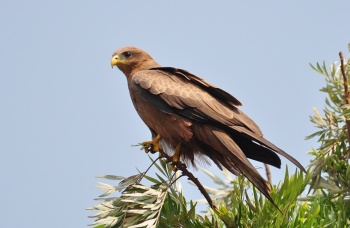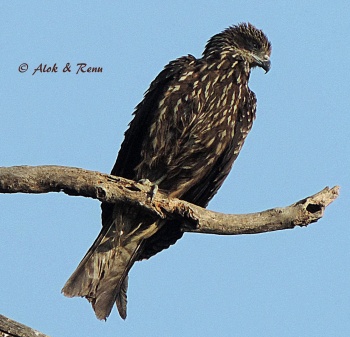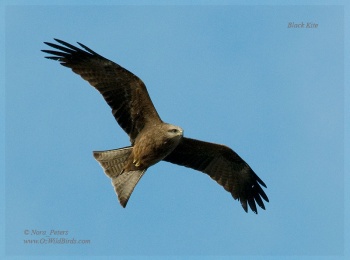- Milvus migrans
Includes Yellow-billed Kite; Black-eared Kite
Identification
Length 44–66 cm (17¼-26 in), wingspan 135-155 cm, weight 560-940 g
- Dull pale brown crown, back of head and nape, with dark brown streaks
- Dull brown chin, throat and breast with darker stripes
- Rufous underwings
- Brown-grey tail barred darker
- Black bill with yellow at base of lower mandible (but see also Subspecies, below)
- Yellow cere
- Pale grey-yellow iris surrounded by a black line
- Yellow legs and toes with black claws
- Shallowly forked tail, looking triangular when spread
- In flight shows 6 free primaries
Females are marginally larger, darker and redder than males. Juveniles differ in having a dark iris, and more mottled plumage, each feather tipped with a greyish white or ferruginous patch. The bands on the tail are less distinct.
Similar Species
Does not have the deeply forked tail of a Red Kite, but can look almost as rufous. The tail of Black Kite is also shorter; on the sitting bird, primaries reach the end of the tail on Black Kite but reach the base of the fork in the tail on Red Kite. Black Kite has less contrast between dark primary tips and white primary bases. Black Kite shows six free primary tips in the extended wing, Red Kite shows five.
In Europe and western Asia, distant Marsh Harriers can be confused, particularly when silhouetted on migration high overhead, when the very different hunting manner is not exhibited; it differs in the square tail tip (rounded when spread) and less deeply fingered wingtips. Dark morph Booted Eagles can also be confused. In Australia and Asia, Whistling Kite and juveniles of Brahminy Kite have superficially similar plumage, but have a rounded, not shallowly forked tail.

Photo by volker sthamer
Jimma, Ethiopia, December 2010
Distribution
Eurasia, Africa and Australia.
Black Kite (see Subspecies, below) breeds across mainland Europe from Iberia east to the Urals, and also in northwest Africa and the Cape Verde Islands. Common and widespread in Spain but patchy in France and central Europe, Italy and Greece. Absent from the British Isles and most of Scandinavia but a small number breed in southern coastal Finland and a rare breeder in Sweden. Has bred regularly in Belgium since the 1970s and first breeding for the Netherlands took place in 1996. Breeding in Finland in 2002 was the first for decades.
In Asia breeds across most of Turkey, the Middle East and east across temperate and tropical Asia to the Pacific coast of Russia, Japan and China. To the south breeds throughout India and Sri Lanka and southeast Asia to southern Thailand. Also breeds in Sulawesi, eastern New Guinea and the Bismarck Archipelago. Widespread in much of Australia, particularly the north and centre and absent only from the southern coastal regions.
In Africa, Yellow-billed Kite (see Subspecies, below) breeds in the southwestern Arabian Peninsula, Egypt, and throughout sub-Saharan Africa from Senegal to Somalia and south to the Cape. In winter (September to March), it is joined by Black Kites from Europe.
Northern populations are migratory and winter to the south. Most European birds winter in sub-Saharan Africa although a few may remain in southern Europe in winter and occasionally wintering birds occur north to southern Scandinavia. Dispersal of young birds can start in late June but migration begins in late July-August, and most have left breeding areas by September. Migrants concentrate at narrow sea-crossings during August-October, the peak period being mid-August to mid-September. Numbers are highest at Gibraltar, but also occurs in thousands at the Bosphorus and at Borçka in Turkey. Smaller numbers occur as migrants through Italy.
The return movement in spring occurs February-May with a peak in March-April and the same routes are used. Regularly seen north of the main breeding range, and there has been some expansion of range in Europe in recent decades. A scarce passage migrant in Britain with an average of 20-25 records per year, mostly in east and south-east England in the period mid April-early June, with occasional autumn records. One or two recent breeding attempts (including hybridisation with Red Kite) have occurred in Britain, and more may occur in the future.
Vagrants also recorded in the Channel Islands and Iceland. In Australia vagrants recorded on the south coast and Tasmania.
Taxonomy
Subspecies
Five subspecies, or seven when Yellow-billed Kite is included, are recognised:[1]
- Black Kite Milvus migrans sensu stricto
- Black bill with basal yellow cere, dark brown plumage faintly streaked in close view, very shallow tail fork
- M. m. migrans
- Most of the Western Palearctic; winters in Africa
- M. m. lineatus
- Temperate central and eastern Asia; winters in southern Asia
- M. m. formosanus
- Taiwan and Hainan
- M. m. govinda
- India and southeast Asia
- M. m. affinis
- Eastern Indonesia (Sulawesi, New Guinea) and Australia.
- Yellow-billed Kite Milvus [migrans] aegyptius
- Yellow bill as adults (but black with basal yellow cere in juveniles), slightly more deeply forked tail, and plainer plumage, more rusty-brown below. Genetically distinct, more closely related to Red Kite than to nominate Black Kite, and now recognised by some authors as a separate species, Milvus aegyptius[2][3][4]. However this split not recognized by Clements et al.[1]or Christides et al.[12]
M. m. tenebrosus, described from the Cape Verde Islands, is now considered a synonym of M. m. migrans[4]. The three Asian subspecies are collectively known as Black-eared Kite and sometimes considered a separate species, though this is not supported by genetic data[3][4].
Habitat
Often close to water, near rivers, lakes and seacoasts and in the south of range closely associated with man. There it is frequent around towns and villages, refuse-tips and slaughterhouses; also patrols roads for roadkill animals. Breeds in tall trees in open or sparsely wooded country.
Behaviour
Usually gregarious, especially on migration.
Diet
The diet includes live prey (rodents, small birds) as well as fish, household refuse and carrion.
Breeding
They nest in forest trees, often semi-colonially, close to other kites.
Vocalisation
Melodious calls given by an adult sitting on a high street-light pole may be heard in the file below :
Recording © by Alok Tewari
Faridabad, Haryana, India, July-2015
References
- Clements, J. F., T. S. Schulenberg, M. J. Iliff, D. Roberson, T. A. Fredericks, B. L. Sullivan, and C. L. Wood. 2018. The eBird/Clements checklist of birds of the world: v2018. Downloaded from http://www.birds.cornell.edu/clementschecklist/download/
- Gill, F & D Donsker (Eds). 2019. IOC World Bird List (v9.1). doi : 10.14344/IOC.ML.9.1. Available at http://www.worldbirdnames.org/
- Scheider, J., Wink, M., Stubbe, M., Hille, S., & Wiltschko, W. (2004). Phylogeographic relationships of the Black Kite Milvus migrans. Pages 467–472 in Chancellor, R. D., & Meyburg, B-U. [eds.], Raptors worldwide: proceedings of the VI World Conference on Birds of Prey and Owls. World Working Goup on Birds of Prey, Berlin, Germany.
- Johnson, J. A., et al. (2005). Prioritizing species conservation: does the Cape Verde kite exist? Proc. Roy. Soc. B 272: 1365–1371.
- Lepage D. 2007. "Milvus aegyptius" downloaded 17 September 2007.
- BirdCheck.co.uk
- Birdforum thread discussing id of Red vs Black Kite
- Birdforum thread discussing the subspecies of Black Kite including link to id hints
- DeCandido, R., Subedi, t., Siponen, M., Sutasha, K., Pierce, A., Nualsri, C. & Round, P.D. (2013) Flight identification of Milvus migrans lineatus 'Black-eared' Kite and Milvus migrans govinda 'Pariah' Kite in Nepal and Thailand. BirdingASIA 20:32-36
- Orta, J., Marks, J.S., Garcia, E.F.J. & Kirwan, G.M. (2019). Black Kite (Milvus migrans). In: del Hoyo, J., Elliott, A., Sargatal, J., Christie, D.A. & de Juana, E. (eds.). Handbook of the Birds of the World Alive. Lynx Edicions, Barcelona. (retrieved from https://www.hbw.com/node/52978 on 26 March 2019).
- Rasmussen, P.C. & Anderton, J.C. (2012) Birds of South Asia. The Ripley Guide. Vols. 1 and 2. Second Edition. Smithsonian Institution. Michigan State University & Lynx Edicions, Washington. D.C., Michigan & Barcelona.
- Christidis et al. 2018. The Howard and Moore Complete Checklist of the Birds of the World, version 4.1 (Downloadable checklist). Accessed from https://www.howardandmoore.org.
Recommended Citation
- BirdForum Opus contributors. (2024) Black Kite. In: BirdForum, the forum for wild birds and birding. Retrieved 16 April 2024 from https://www.birdforum.net/opus/Black_Kite
External Links
GSearch checked for 2020 platform.









